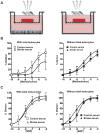Circulating leucocytes perpetuate stroke-induced aortic dysfunction
- PMID: 28737253
- PMCID: PMC5623140
- DOI: 10.1113/EP086510
Circulating leucocytes perpetuate stroke-induced aortic dysfunction
Abstract
What is the central question of this study? Does a stroke event influence aortic endothelial function; and what is the role of peripheral circulating leucocytes in stroke on the vascular reactivity of the aorta? What is the main finding and its importance? In vitro co-culture experiments demonstrated that aortic endothelium-dependent relaxation was impaired when rat aortic rings were co-cultured with leucocytes stimulated with serum from stroke patients. Impaired vascular reactivity was not observed in aortic rings without leucocytes stimulated with serum from stroke patients or age-matched control patients with or without leucocytes. These data suggest that leucocyte-dependent altered aortic endothelium-dependent relaxation with stroke and the systemic consequences of stroke on vascular inflammation may occur in the aorta. Post-stroke inflammation has been linked to poor stroke outcomes. The vascular endothelium senses and responds to circulating factors, in particular inflammatory cytokines. Although stroke-associated local cerebrovascular dysfunction is well reported, the effects of a stroke on conduit artery function are not fully understood. We tested the hypothesis that serum from stroke patients triggers leucocyte-dependent aortic endothelial dysfunction that is associated with elevated concentrations of cytokines. Total leucocytes were isolated from healthy individuals, and the cells were incubated in serum from control subjects or stroke patients for 6 h. The quantity of cytokines in media was determined using an immunoassay. Vascular reactivity was determined by the rat aortic rings that were co-cultured with or without leucocytes and stimulated with serum samples from control subjects or stroke patients. Endothelium-dependent dilatation was significantly impaired in aortic rings co-cultured with leucocytes plus serum from stroke patients (50 ± 30 versus 85 ± 13%, P < 0.05) versus serum from control subjects. In contrast, no difference was observed in aortic function stimulated with serum from control subjects or stroke patients without total leucocytes. Likewise, total leucocyte-derived cytokine concentrations were significantly increased in a time-dependent manner on stimulation with serum from stroke patients (P < 0.05). These observations support the concept that the increased response of leucocytes drives the development of stroke-associated vascular endothelial dysfunction. As such, pharmacologically targeting the source of inflammatory cytokines might alleviate stroke-associated peripheral vascular dysfunction.
Keywords: cytokines; endothelial function; inflammation; oxidative stress; stroke; vascular reactivity.
© 2017 The Authors. Experimental Physiology © 2017 The Physiological Society.
Figures



References
Publication types
MeSH terms
Substances
Grants and funding
LinkOut - more resources
Full Text Sources
Other Literature Sources
Medical
Research Materials

